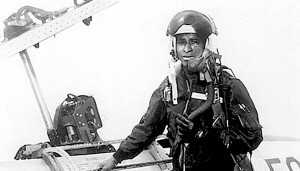NASA celebrates legacy of first Black American astronaut
26th December 2017 · 0 Comments
By Erick Johnson
Contributing Writer
(Special from NNPA’s Chicago Crusader) — Fifty years ago, a tragic accident ended the groundbreaking career of Major Robert H. Lawrence, Jr., a Chicago native and stellar Air Force pilot who became America’s first Black astronaut.
On December 8, 2017—the 50th anniversary of his death—NASA honored his often-ignored legacy and contributions to the agency.
Earlier this year, the Chicago Crusader reported about the lack of visibility of NASA’s first Black American astronaut and helped to raise awareness about Lawrence’s incredible journey.
In planning a story for its annual Black History Month edition, Chicago Crusader staffers discovered that little was being done to honor Lawrence, while NASA held memorials to mark the 50th anniversary of three white astronauts who perished in a fire aboard the Apollo 1 space module, during a preflight test.
The Crusader story lauding Lawrence’s achievements was published in dozens of Black newspapers after the National Newspapers Publishers Association (NNPA) carried it on its newswire.
Born in 1935 to the late Gwendolyn Duncan and Robert H. Lawrence, Sr., the future Air Force pilot was a man ahead of his time. Long before magnet and STEM programs were part of the high school curriculum, Lawrence excelled in math and science.
At 16, he graduated with honors from Englewood High School and went on to earn a bachelor’s degree in chemistry from Bradley University. He married the late Barbara Cress from the prominent Chicago Cress family and entered the Air Force at age 21 before earning a doctorate in physical chemistry from Ohio State University, becoming the first astronaut at NASA to earn a doctorate degree.
As a United States Air Force pilot, Lawrence accumulated over 2,500 flight hours. In June 1967, Lawrence graduated from the U.S. Air Force Test Pilot School (Class ‘66B) at Edwards Air Force Base, Calif. In that same month, he was selected by the USAF as an astronaut for their Manned Orbital Laboratory (MOL) program, thus becoming the first Black astronaut.
Lawrence died while training another pilot, Maj. John Royer, to perform the “flare” maneuver—an operation that Lawrence had already mastered— in the F-104 Starfighter.
According to NBC News, “Lawrence’s memory languished in obscurity” partly due to the fact that, the Pentagon only recognized someone as an “astronaut” if they actually flew to an altitude above 50 miles.
However, Rep. Bobby Rush (D-Va.) mounted a campaign that forced NASA to put Lawrence’s name on the Space Mirror Memorial in 1997—thirty years after Lawrence’s death.
“On Dec. 8, 1997, on the thirtieth anniversary of his death, Lawrence had his name unveiled on the Florida memorial,” NBC News reported.
The ceremony recognizing Lawrence, earlier this month—although spirited, at times—was a somber one for the 300 guests that included decorated NASA astronauts, dignitaries, relatives, and friends, who had flown and driven miles across the country to honor Lawrence at the Kennedy Space Center in Cape Canaveral, Fla.
Lawrence’s older sister, Dr. Barbara Lawrence, attended and spoke; another prominent Chicago resident who was present was E. Dawn Griffin, the oldest daughter of Ernest Griffin, founder of Griffin Funeral Home in Bronzeville. The Griffin Funeral Home, which closed in 2012, handled the funeral arrangements for Lawrence.
Members from Lawrence’s college fraternity, Omega Psi Phi, also attended to honor one of their own. On the sprawling grounds of the NASA facility, they participated in a two-and-a-half-hour ceremony that began at the Center for Space Education and culminated with an emotional wreath-laying ceremony at the base of the national Space Mirror Memorial, a massive black granite structure where Lawrence’s name is among those of 20 astronauts who either died in flight or in training.
The ceremony brought out some of NASA’s astronauts and biggest officials. Charles Bolden, America’s first Black NASA chief administrator, and Stephanie Wilson, the second Black female astronaut, attended the service. Another Black astronaut, Winston Scott, played the trumpet in a band that performed various jazz songs, including, “Fly Me to the Moon.” Reportedly, jazz was one of Lawrence’s favorite musical genres.
Dr. Herman B. White Jr., a physicist and lecturer at Bradley University in Peoria, Ill., Lawrence’s alma mater, gave a presentation where a memorial scholarship and a conference room bear Lawrence’s name. Recently, Ohio State University in Columbus, Ohio renamed a dormitory in Lawrence’s honor.
Bolden, who piloted the space shuttles Columbia and Discovery, praised Lawrence for his spirit. “He took that first step,” Bolden said. “If he had lived, he would have been flying on that space shuttle also.”
Col. Robert Cabana, who flew on four shuttle missions, agreed.
“Major Robert H. Lawrence truly was a hero,” said Cabana. “He set the stage for what was to come.”
Dr. Barbara Lawrence shared her experiences with her brother as they grew up on the South Side of Chicago. She said, when Robert was young, he was a very disciplined student and dedicated to learning.
“I’m truly proud to have been his sister,” she shared. “He wasn’t interested in being the first Black astronaut. He was only interested in being given the opportunity to do what he wanted to do. I’m sorry he wasn’t here a little longer, but I think his job was one that was well done.”
This article originally published in the December 25, 2017 print edition of The Louisiana Weekly newspaper.




